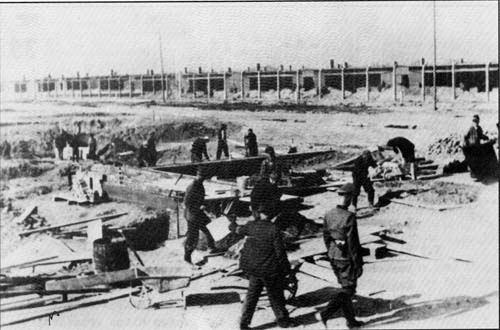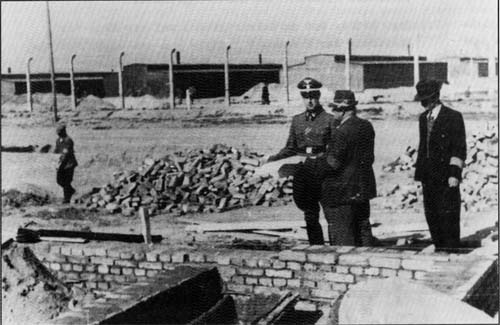As a result of Hoess' visit to SS Colonel Blobel. the exhumation and incineration of the corpses buried earlier began at Birkenau on 20th September, first on pyres, then in open air ditches. To accelerate the process, the bodies were doused with crude oil, which was later replaced by methanol.
On 22nd December, the Bauleitung Drawing Office produced a situation plan of the POW camp, drawing 1697, this time with three construction stages (with a maximum capacity of 140,000 prisoners), still with only two Krematorien (II and III), giving 1 incineration muffle for 4,700 people. Even though the construction of Krematorien IV and V had been decided upon, their location did not yet figure on the drawing. The double track railway did not stop “at the gates to the Krematorien” but continued beyond them [Document 20].
SS Lieutenant General Pohl, head of the SS WVHA, inspected the Auschwitz camp on 23rd September and was able to sec that an epidemic was raging there.
Between 18th and 26th September, Vedag finally sent the long awaited damp proofing materials to Bauleitung, but this did not prevent them from asking Huta on 26th for “standard” materials release authorizations in order to regularize the situation. At the same time they asked Huta to pass on a letter to Vedag foreman Krause whose exact address they did act know!
Probably at Pohl’s request, Dr Ernst Robert Grawitz, Head of the German Red Cross, made a thorough inspection of the camp on 25th September. He saw the sick quarters overflowing, corpse storage, the temporary water treatment installations, the extermination of the Jews and the incineration of corpses in open air ditches.
On 29th September, Huta sent Vedag the release issued by Himmler’s headquarters, hoping that this would settle the question of the formalities. But this was not to be, for on 1st October Vedag replied to Huta that so far as they were concerned this release had no legal value and the papers had to be filled in, signed and sent solely to the Reich office for mineral oils. Despite these administrative difficulties, damp proofing work at BW 30 proceeded without a hitch until 2nd October, when worked stopped due to a problem with drain pipes that had to pass through the proofing material.
On 7th October, the Bauleitung signed the second request for the release of damp proofing material, this time for worksite 30a (Krematorium III).
On 13th October, the Auschwitz Bauleitung informed the Head of Office C/IV of the SS WVHA in Berlin of the cost of the contracts for the construction of the KGL (POW camp) according to the estimates of the civilian firms Lenz & Co and Huta, and the cost of the shell of a new crematorium in this camp [Document 12]. This letter mentions the urgency of constructing the new crematorium, an argument often advanced as proof of its criminal intent, but this argument is invalid, because for the SS, ALL construction was urgent. On the other hand, this document is still vital, for it proves that the Krematorien were associated with “special actions”.
On 14th October. there was a meeting in the Auschwitz Bauleitung building between its senior staff and two Huta representatives Herr Stephan and Herr Sadora. The floors of the basements in Krematorien II and III, originally planned to be 12 cm thick, were increased to 50 cm of non- reinforced concrete [Bauleitung drawing 933
[934](p) and Huta drawings 109/13a/14a and /16a].
On 17th October, Vedag foreman Krause, working with Bauleitung materials on the damp proofing of the basements of Krematorium III. estimated that this would be finished by 31st October.
On 19th October, Vedag asked for release requests for the damp proofing materials for Krematorium III, not wanting to deliver them without “standard” authorization (which is why the SS had advanced materials to foreman Krause). Messrs Karl Falck completed the first stage of the drainage work at worksite 30, commenced ten days earlier on 9th October.
On 24th October, Huta sent the Bauleitung a first batch of twenty pages of static calculations accompanied by its drawings 109/3, 4, 5 and 6 of Krematorien II and III, Huta project number 7015/IV. These static calculations also concerned the chimneys, identical for the two buildings, which were no doubt designed by the Bauleitung on the basis of drawings supplied by Topf.
On 26th October. there was an incident at worksite 30a concerning the sizing of the concrete before damp-proofing with disagreement between SS Second Lieutenant Janisch and foreman Krause, the latter considering the operation unnecessary in view of the damp and rainy weather, It is not known how the argument ended, but the suspicion must be that it cost Krause very dear, because a letter of 4th May 1943 indicates that he had been called up in the Wehrmacht [PMO file BW 30/30, page 3], whereas if he had played his cards right he should have been able to volunteer for the Waffen SS and get himself detached to the Auschwitz Bauleitung, a real “cushy number” compared with the “external” fronts.
During the period 27th October to 11th November, the only documents referring to BW 30 are the “Arbeitzeit Bescheinigungen / Timesheets” of the fitter Willi Koch concerning the foundations for the furnaces and the underfloor flues, and the “Bauberichten / Construction reports” on the erection of the furnaces [PMO file BW 30/41].
On 12th November, Huta produced drawing 109/9 (Dissecting room ceiling), and on 13th, drawing 109/10 (Waste incinerator room ceiling supporting beams and the lintel). These were sent to the Bauleitung on 14th October, together with more static calculations concerning project number 7015/IV. |
|
 |
Document 17 |
| Document 17a |
 |
|
| |
Documents 17 and 17a
[PMO neg no 20995/247 (17)
and /248 (17a)]
An example of a worksite inspection visit, of which there were many in Birkenau. In this particular case, the site is the “Wasseraufbereitungsanlage / Water treatment installation” located to the east of the external road running along Birkenau BIIa parallel with “Graben / Drainage ditch” C-C1 running through the second construction stage (BA II). These photographs were taken in the summer of 1943 and the SS officer is probably SS Lieutenant Jothann, who was shortly to become Head of the Bauleitung. |
|
|
|

